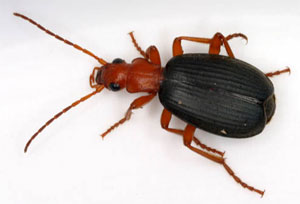The amazing bombardier beetle
Patrick Coin, wikipedia.org

The tiny bombardier beetle could not possibly have evolved. His defence mechanism is amazingly complicated, and could only have been created with all the parts working together perfectly. From twin ‘exhaust tubes’ at his tail, this beetle fires into the face of his enemies boiling-hot noxious gases with a loud pop.
How can this be? German chemist Dr Schildknecht discovered that the beetle mixes two chemicals (hydrogen peroxide and hydroquinone) which would usually form a dirty ugly mixture. The well-designed beetle uses a special ‘inhibitor’ chemical to keep the mixture from reacting. How then can the explosion instantaneously occur when needed?
Dr Schildknecht discovered that in the beetle’s specially designed combustion tubes are two enzymes called catalase and peroxidase which make chemical reactions go millions of times faster. These chemicals catalyze the extremely rapid decomposition of hydrogen peroxide into water and oxygen and the oxidation of hydroquinone into quinone, causing them to violently react and explode—but not so soon as to blow up the beetle, of course!
Common sense tells us that this amazing little insect cannon which can fire four or five ‘bombs’ in succession could not have evolved piece by piece. Explosive chemicals, inhibitor, enzymes, glands, combustion tubes, sensory communication, muscles to direct the combustion tubes and reflex nervous systems—all had to work perfectly the very first time—or all hopes for ‘Bomby’ and his children would have exploded!
(From Nature Friend magazine, P.O. Box 73, Goshen, Indiana, 46526 USA, March, 1989. Used by permission.)
Note: subsequent research has clarified that there is no ‘special inhibitor’ involved. See: Bombardier idea.

Readers’ comments
Comments are automatically closed 14 days after publication.